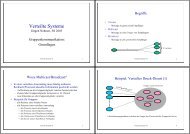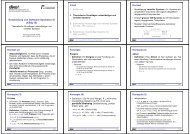Systemsoftware
Systemsoftware
Systemsoftware
Create successful ePaper yourself
Turn your PDF publications into a flip-book with our unique Google optimized e-Paper software.
Semantik von Signal()<br />
(1) {B∧(CV'=∅)} CV.Signal ( ) {B∧(CV=∅)}<br />
• Variante I: kein Besitzwechsel, Befreiung höchstens eines Threads aus CV<br />
(2) {B∧(CV'≠∅)} CV.Signal ( ) {B∧(CV=CV'-{P x },P x ∈CV')∧(P=P'∪{P x })}<br />
• Variante II: kein Besitzwechsel, Befreiung aller Threads aus CV<br />
(2') {B∧(CV'≠∅)} CV.Signal ( ) {B∧(CV=∅)∧(P=P'∪CV')}<br />
• Variante III: Besitzwechsel vom signalisierenden auf einen signalisierten<br />
Thread (Hoare 1974)<br />
(2'') {B∧(CV'≠∅)} CV.Signal ( ) {B∧(P=P'∪{P r }∧(P r =Blocked) ∧(CV=CV'- {P x },<br />
P x ∈CV')∧(P x =Ready)}<br />
<strong>Systemsoftware</strong> - Lektion X 7<br />
Programmierregeln<br />
• Signal-Varianten I und II<br />
– keine Garantie, dass die Bedingung B nach Wait erfüllt ist, deshalb<br />
Benutzung von Wait immer in der while-Schleife:<br />
while (!B) Conditionvariable.Wait();<br />
• Signal-Variante III:<br />
– war B unmittelbar vor Signal erfüllt, dann ist B auch garantiert nach Wait<br />
erfüllt, deshalb ist die Benutzung von Wait auch in if-Anweisung sicher:<br />
if (!B) Conditionvariable.Wait();<br />
<strong>Systemsoftware</strong> - Lektion X 8






